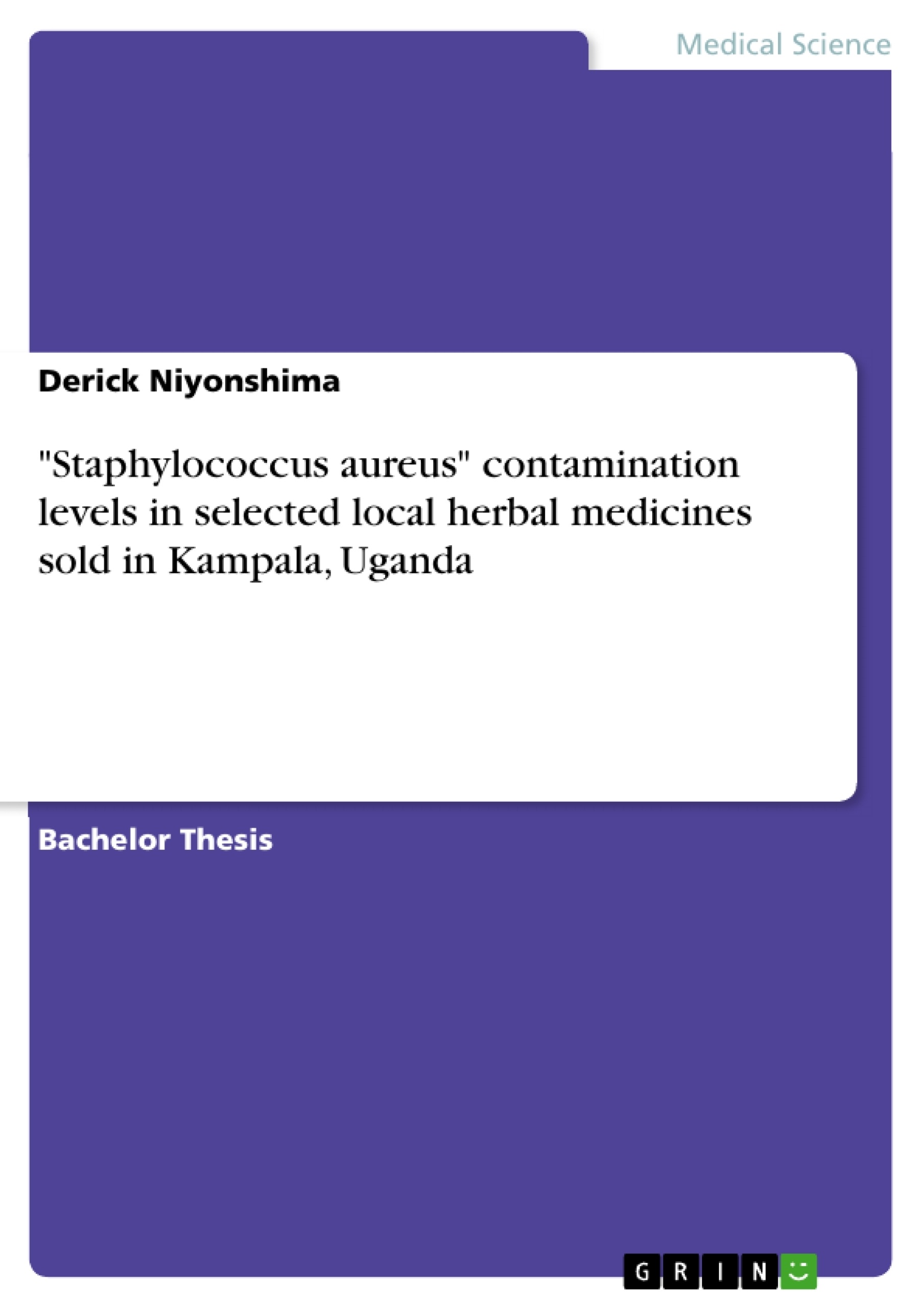Herbal medicine use in Uganda and the world at large is at its peak because of the documented efficacy, effectiveness, cheap cost and less side effects. The estimates of herbal medicine users in the world is 80% and 60% in Uganda, yet with all this demand, less effort has been put to ensure that they are free from bacterial contamination.
The study therefore aimed at determining Staphylococcus aureus contamination of selected liquid herbal medicines sold in Kampala, Uganda with the following specific objectives; to provide an update on the different local herbal medicines sold in Kampala, Uganda and the conditions they treat; to determine Staphylococcus aureus contamination levels of selected liquid local herbal medicines sold in Kampala, Uganda; and to establish the antibacterial susceptibility patterns of isolated Staphylococcus aureus.
A questionnaire was used to collect data on the different local herbal medicines sold in Kampala, Uganda. To determine levels of Staphylococcus aureus contamination, microbial culture was performed on 30 selected liquid herbal medicine samples. In addition Staphylococcus aureus susceptibility patterns were determined by subjecting isolated Staphylococcus aureus species to gentamicin 10μg, chloramphenicol 30 30μg ampicillin 10μg, penicillin 10U and tetracycline 30μg. A total of one hundred and seventy local herbal medicines were identified and classified into twenty five categories basing on conditions they treat.
I therefore recommend that herbal medicines should be tested for bacterial quality by regulatory bodies before being sold to patients to avoid Staphylococcus aureus infection hence avoiding treatment costs. In addition, herbal medicine practitioners should embark on good manufacturing practices to avoid contamination of herbal medicines.
TABLE OF CONTENTS
DEDICATION
ACKNOWLEDGEMENT
ABBREVIATIONS
LIST OF TABLES
ABSTRACT
CHAPTER ONE: INTRODUCTION
1.1 Background
1.2 Problem statement
1.3 Justification
1.4 Study objectives
1.4.1 General objective
1.4.2 Specific objectives
1.5 Research questions
CHAPTER TWO: LITERATURE REVIEW
2.1 Herbal medicine
2.1.1 Classification of herbal medicine
2.1.2 Uses of herbal medicine
2.2 Bacterial quality of herbal medicines
2.2.1 Public health complications of contaminated herbal medicine
2.3 Biology of Staphylococcus aureus
2.3.1 Transmission of Staphylococcal infections
2.3.2 Diseases caused by Staphylococcus aureus
2.4 Antibacterial resistance
2.4.1 Antibacterial resistance mechanisms of Staphylococcus aureus
CHAPTER THREE: MATERIALS AND METHODS
3.1 Study area
3.2 Study design
3.3 Data collection
3.3.1 Qualitative data collection
3.3.2 Quantitative data collection
3.4 Sample size
3.5 Sampling strategy
3.6 Sample selection criteria
3.6.1 Inclusion criteria
3.6.2 Exclusion criteria
3.7 Staphylococcus aureus culture
3.7.1 Labelling test tubes and culture plates in the laboratory
3.7.2 Processing of samples
3.7.3 Preparation of media
3.7.4 Culture of samples
3.7.5 Plate reading bacterial identification and colony plate count
3.8 Antibacterial susceptibility testing
3.9 Quality control and quality assurance
3.10 Data analysis
3.11 Study limitation and mitigation
CHAPTER FOUR: PRESENTATION AND INTERPRETATION OF RESULTS
4.1 Local herbal medicines sold in Kampala, Uganda
4.2 Level of contamination of herbal medicine with Staphylococcus aureus
4.2.1 Growth patterns of Staphylococcus aureus
4.2.2 Colony forming units of Staphylococcus aureus
4.3: Antibacterial susceptibility patterns of Staphylococcus aureus
CHAPTER FIVE: DISCUSSION OF RESULTS
5.1 Local herbal medicines sold in Kampala, Uganda
5.2 Level of contamination of herbal medicine with Staphylococcus aureus
5.3 Antibacterial susceptibility patterns of Staphylococcus aureus
CHAPTER SIX: CONCLUSION AND RECOMMENDATION
6.1 Conclusion
6.2 Recommendation
REFERENCES
APPENDICES
Appendix 1: Coagulase test
Appendix 2: labelling, counting and isolating colonies in pictures
Appendix 3: Map of Kampala city, Uganda
Appendix 4: Questionnaire
Appendix 5: List of local herbal medicines sold in Kampala and the conditions they treat
- Arbeit zitieren
- Derick Niyonshima (Autor:in), 2016, "Staphylococcus aureus" contamination levels in selected local herbal medicines sold in Kampala, Uganda, München, GRIN Verlag, https://www.grin.com/document/427756
-

-

-

-
Laden Sie Ihre eigenen Arbeiten hoch! Geld verdienen und iPhone X gewinnen. -

-
Laden Sie Ihre eigenen Arbeiten hoch! Geld verdienen und iPhone X gewinnen. -

-
Laden Sie Ihre eigenen Arbeiten hoch! Geld verdienen und iPhone X gewinnen. -

-
Laden Sie Ihre eigenen Arbeiten hoch! Geld verdienen und iPhone X gewinnen. -

-
Laden Sie Ihre eigenen Arbeiten hoch! Geld verdienen und iPhone X gewinnen. -

-
Laden Sie Ihre eigenen Arbeiten hoch! Geld verdienen und iPhone X gewinnen. -

-
Laden Sie Ihre eigenen Arbeiten hoch! Geld verdienen und iPhone X gewinnen. -

-
Laden Sie Ihre eigenen Arbeiten hoch! Geld verdienen und iPhone X gewinnen. -

-
Laden Sie Ihre eigenen Arbeiten hoch! Geld verdienen und iPhone X gewinnen. -

-
Laden Sie Ihre eigenen Arbeiten hoch! Geld verdienen und iPhone X gewinnen. -

-
Laden Sie Ihre eigenen Arbeiten hoch! Geld verdienen und iPhone X gewinnen. -

-
Laden Sie Ihre eigenen Arbeiten hoch! Geld verdienen und iPhone X gewinnen.

